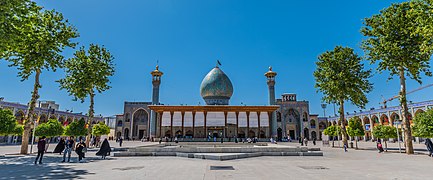
Shiraz
Shiraz (Persian: شیراز; /ʃɪəˈrɑːz/ ; [ʃiːˈɾɒːz] )[a] is the fifth-most-populous city of Iran[b] and the capital of Fars Province,[4] which has been historically known as Pars (پارس, Pārs) and Persis.[5] As of the 2016 national census, the population of the city was 1,565,572 people, and its built-up area with Sadra was home to almost 1,800,000 inhabitants.[6] A census in 2021 showed an increase in the city's population to 1,995,500 people.[7] Shiraz is located in southwestern Iran on the rudkhaneye khoshk (lit. 'dry river') seasonal river. Founded in the early Islamic period, the city has a moderate climate and has been a regional trade center for over a thousand years.
This article is about the city in Iran. For the grape known as Shiraz, see Syrah. For the wine once produced in the Iranian city of Shiraz, see Shiraz wine. For other uses for the same name, see Shiraz.
Shiraz
Persian: شیراز
The earliest reference to the city, as Tiraziš, is on Elamite clay tablets dated to 2000 BCE.[8] The modern city was founded by the Sasanian dynasty and restored by the Umayyad Caliphate in 693 CE and grew prominent under the successive Iranian Saffarid and Buyid dynasties in the 9th and 10th–11th centuries, respectively. In the 13th century, Shiraz became a leading center of the arts and letters, due to the encouragement of its ruler and the presence of many Persian scholars and artists. Two famous poets of Iran, Hafez and Saadi, are from Shiraz, whose tombs are located on the north side of the current city boundaries.
Shiraz is one of the top tourist cities in Iran and is known as the city of poets, literature, and flowers.[9][10] It is also considered by many Iranians to be the city of gardens due to the presence of many gardens and fruit trees that can be seen throughout the city, such as Eram Garden. Shiraz is also a famous tourist destination in the world. Every year many tourists come from around the world to visit the city. Shiraz has historically had major Jewish and Christian communities. The crafts of Shiraz consist of inlaid mosaic work of triangular design; silverware; pile carpet-weaving and weaving of kilim, called gilim and jajim in the villages and among the tribes.[11] Dominant industries in the city include the production of cement, sugar, fertilizers, textile products, wood products, metalwork, and rugs. Shiraz also has a major oil refinery and is a major centre for Iran's electronic industries: 53 percent of Iran's electronic investment has been centred in Shiraz.[12] The city is home to Iran's first solar powerplant.[13] Recently, Shiraz's first wind turbine has been installed above Mount Babakuhi near the city.
The city holds significant importance as a tourism destination in Iran, with its cultural heritage being globally recognized. [74]
List of neighborhoods in Shiraz:
Higher education[edit]
Shiraz is home to a vibrant academic community. The Shiraz University of Medical Sciences was the first university in Shiraz and was founded in 1946. Much older is the august Madrasa-e-Khan, or Khan Theological School, with about 600 students; its tile-covered buildings date from 1627.[78]
Today Shiraz University is the largest university in the province, and one of Iran's best academic centers. Other major universities in or nearby Shiraz are the Islamic Azad University of Shiraz,[79] Shiraz University of Technology, and Shiraz University of Applied Science and Technology.[80]
The Shiraz Regional Library of Science and Technology is a provincial library serving the public. Virtual University of Shiraz is one of the sub colleges of Shiraz University.


![Imamzadeh Ali ibn Hamzah, nephew of Shah Cheragh and Imam Reza.[38][39]](http://upload.wikimedia.org/wikipedia/commons/thumb/9/9f/Imamzadeh-ye_Ali_Ebn-e_Hamze_%28Shiraz%29_001.jpg/240px-Imamzadeh-ye_Ali_Ebn-e_Hamze_%28Shiraz%29_001.jpg)









